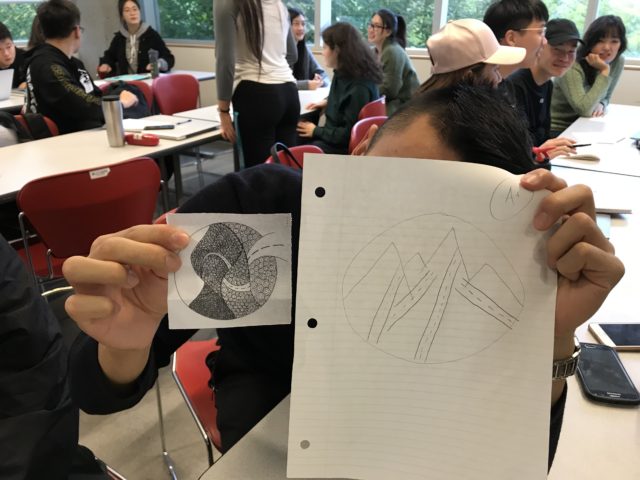Communication Competency

Week 5 – EDUC471D100 – October 6, 2017
I love how this course is evolving. The student-led warm up activity this week was one that exercised and emphasized the Communication Core Competency as described in BC’s New Curriculum. The class was subdivided into groups of 4. Each group is given a picture. The first person who has the picture has to describe what they see to the second person. The second person has to draw what they perceive is being described within a 2-minute time limit. Once complete, the second person describes their drawing to the third person of the group. Finally, the process is repeated once again from the third to the fourth.
The activity resembled the “telephone” activity where messages can be and likely to be revised when told from person to person. The same could be and would be true with this activity. To my surprise, the students did very well. It was not an easy activity and it really relied on communication skills, listening skills, and a wild imagination. I could see how this activity could be used in the English Language Arts courses in K-12 as students are learning descriptive words to depict what they see. You could also use this activity over time (i.e. September, December, April, and June) to see progress in the communication competency over time. It was a fun, engaging, and interactive activity. I would do this in a mathematics class to demonstrate the importance of communication in math.
Journal Reflection Questions – Personalized Learning
How does personalized learning and inclusive education connect to BC’s New Curriculum?
- It’s about acknowledging each student and their strengths. It’s not about looking at homogenizing learners and grading them on how well they have conformed to the expected “learning outcome.” Personalized learning is about choice, interest, and exercising student agency within the framework of the course/subject area. This is not about creating 30 individualized curricula, but rather finding ways in which student can acquire and/or demonstrate their learning. This is where emphasizing curricular competencies and using content as the vehicle can create some flexibility for planning and personalized learning. Personalized learning acknowledges our differences.
How is your learning being personalized in this course?
- Choice was offered for which participation activities students wished to facilitate. Choice was offered in what topic they wish to do their IGNITE presentation on, but it must relate to curriculum development and/or content highlighted in the course. Choice was offered for the final assignment.
How are inclusive practices being used in this course?
- A safe learning environment is created. Student input and voice influences the direction of the course. Different opportunities for students to engage and participate. Tries to include and acknowledge all types of learners in class.
What are some possible benefits of personalized learning and inclusive education for student learning?
- Students can exercise student agency and choice. Students learn more about their learning and what they are good at or interested in. Students feel like they are part of a learning community and we are able to celebrate our differences. We can achieve this within a common framework but can acknowledge our progress relative to ourselves and not others. Feedback would be personally relevant and applicable. All students would feel like their are part of the collective learning process. We are all learners (me included).
My Reflections
We are creating some momentum in this course. I am grateful for the early adopters for setting the stage for the rest of the class. This takes courage and I applaud them. With a solid foundation created by students, the student-led participation activities are getting better and better. I love that students create their own discussion questions from the readings. This week, many of the questions posed on personalized learning were somewhat similar, which I found interesting. There was some skepticism from the discussion. I would expect that when we as a collective of learners have been part of the 20th century learning model of achieving the same goal and being assessed that way. However, I am optimistic as I see topics of student choice as demonstrated in the Wild Card Activity. This week 2 students talked about the importance of drama (aka. action, student participation, or experiential learning) is valuable for students and the learning experience. We participated in an activity that involved math… from the 3 times tables to 7. With more time, we could have realized what the students were trying to convey.
I look forward to the upcoming weeks. We are approaching the halfway mark. I’m excited. We are moving towards assessment and evaluation and how that influences curriculum development and its implementation in context of BC’s New Curriculum.